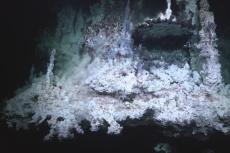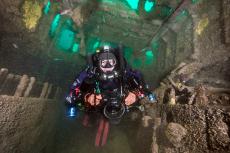Restoring ocean health pays off
Channel Islands Marine Protected Areas appear to be fulfilling their role as refuges for many fish and invertebrate species, a decade of monitoring data show.
Are Marine Protected Areas (MPAs) meeting their ecological goals? Marine scientists from the Partnership for Interdisciplinary Studies of Coastal Oceans (PISCO) monitoring the rocky reef and kelp forest communities in California state waters around the northern Channel Islands off the coast of Santa Barbara finds positive results. Their study represents one of the first opportunities marine biologists have had to examine a network of MPAs, rather than a single location.
The Channel Islands MPAs were formed in 2003, and an analysis of the first ten years of monitoring data shows they appear to be fulfilling their role as refuges for many fish and invertebrate species. After the first five years of protection, scientists found that fish species targeted by fishermen had both greater density (numbers of fish per area) and biomass (total weight per area) inside MPAs as compared to reference sites outside—and this was still true in 2013.
Added bonus
More importantly, the researchers also found increases in fished species outside in the unprotected areas. When fishing is prohibited in one area, fishermen naturally turn their attention to less protected areas and it was feared that this extra effort would deplete the fish stocks outside of MPAs. However, there is no evidence of any depletion. In fact, fish stocks outside of MPAs have also increased over time, although at a slower rate than inside MPAs.
The scientists don't know if fish population increases beyond the MPA borders are related to reduced fishing pressure, spillover from MPAs, favorable environmental conditions, or a combination of all three.
50% protection needed
In a report recently published in the journal Science, researchers from Oregon State University point out that numerous international policy agreements call for protection of 10 percent of coastal and marine areas by 2020, while some conservation organizations and most scientists say 20-50 percent of ocean protection is needed.
The science of marine protected areas is now mature and extensive, they said, and the multiple threats facing the Earth's ocean warrant more accelerated, science-driven action.
Marine protection can range from "lightly protected", which allows some protection but significant extractive activity, to the "full" protection, usually identified as marine reserves. Such areas, covering an almost undectable total area of the ocean a decade ago, are rapidly gaining attention as their social, economic and environmental benefits become more clear. To further speed that progress, the OSU researchers highlighted seven key findings, one of which stressed the need for fully protected areas.
Full protection works
Fully protected and effectively enforced areas generally result in quite significant increases in biomass, size of individuals and diversity inside a reserve. Those benefits in turn often spill over to adjacent areas outside the reserve.
In line with findings from the Channel Islands MPA, the OSU scientists also highlighted the need for connecting habitats. Many species move among habitats during their life cycles, so a range of protected areas will aid in protecting biodiversity and enhancing benefits inside and outside the reserve.
A network, or set of reserves that are connected by the movement of juveniles and adults can provide many of the benefits of a single large area, while still allowing fishing between the reserves. Large and strategically placed reserves can also enhance resilience and assist in adapting to environmental and climatic changes.
It saves money too
Smart planning can reduce costs of creating reserves and increase their economic benefits, in some cases making them more valuable than before the reserve was created.
- Log in to post comments















































